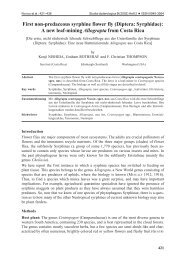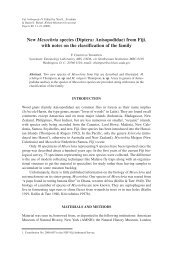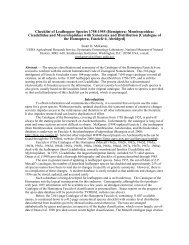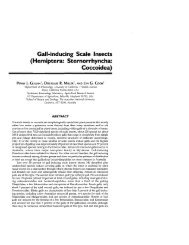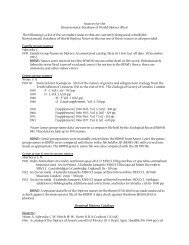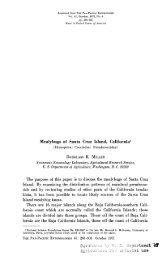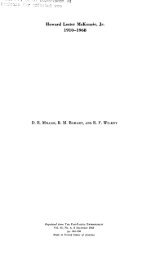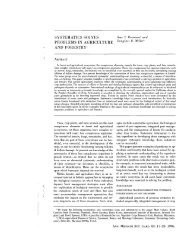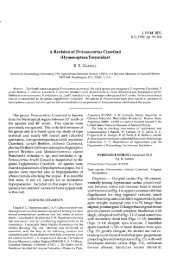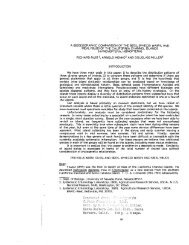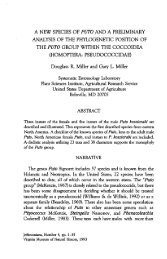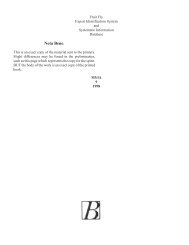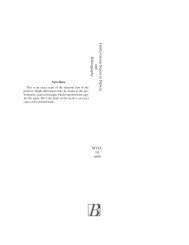Systematic revision of the Family Micrococcidae (Homoptera ...
Systematic revision of the Family Micrococcidae (Homoptera ...
Systematic revision of the Family Micrococcidae (Homoptera ...
Create successful ePaper yourself
Turn your PDF publications into a flip-book with our unique Google optimized e-Paper software.
- 238 <br />
Antennae 6-segmented, 142 (133-148) fL long; segments III and V without conspicuously<br />
long seta, longest seta on segment VI 76 (59-94) fL long.<br />
Notes - The description is based on 9 specimens from 1 locality.<br />
Type material: We have examined <strong>the</strong> holotype <strong>of</strong> this species which has <strong>the</strong> following engraved<br />
on <strong>the</strong> left side <strong>of</strong> <strong>the</strong> slide «Molluscococcus/ fibrillae Hall/ Hyparrhenia/ filipendula/<br />
(rootlets)/ South/ Marendellas» right side with label «BM 1943-53/834/ GENOTYPE/ TYPE/ W.J.<br />
HALL! 15.111.40». We also have examined 21 paratypes deposited in <strong>the</strong> Natural History<br />
Museum, London and 11 in <strong>the</strong> U. S. National Collection at Beltsville, Maryland.<br />
Specimens examined: Zimbabwe [Sou<strong>the</strong>rn Rhodesia], South Marendellas, II-23-36, on Hyparrhenia<br />
jilipendula, 12 adult females on 6 slides (BMNH); Marendellas, III-9-28, on H. jilipendula,<br />
4 adult females on 2 slides (BMNH); Inkomo, 111-26-28, on H. jilipendula, 8 adult females<br />
and 9 first instars on 6 slides (BMNH, USNM).<br />
PHYLOGENETIC ANALYSIS<br />
The relationship <strong>of</strong> Micrococcus and Molluscococcus with o<strong>the</strong>r scale taxa<br />
has been controversial since <strong>the</strong> first species was discovered. FERRIS (1921,<br />
1957) suggested that Micrococcus belonged in what is now called <strong>the</strong> family<br />
Eriococcidae; SILVESTRI (1939) suggested that it should be associated with <strong>the</strong><br />
mealybugs; and KOTEJA (1974) indicated that it should be a separate family related<br />
to <strong>the</strong> Coccidae.<br />
To test <strong>the</strong>se hypo<strong>the</strong>ses, a phylogentic analysis was implemented including<br />
representatives <strong>of</strong> each <strong>of</strong> <strong>the</strong> groups suggested as close relatives. Using<br />
characteristics <strong>of</strong> adult females, adult males, and first instars, we anticipated<br />
that we would be able to provide definitive evidence about <strong>the</strong> placement <strong>of</strong><br />
this peculiar group <strong>of</strong> scale insects.<br />
Characters. Character distributions for 20 taxa and 39 characters are presented<br />
in <strong>the</strong> matrix in table 1. Unknown characters were coded as missing data.<br />
Adultfemale<br />
1. Asterolecanium type 8-shaped pores 0 = absent, 1 = present<br />
2. Small dark-rimmed 8-shaped pores 0 = absent, 1 = present<br />
3. Translucent pores on hind legs 0 = present, 1 = absent<br />
4. Tubular ducts 0 = not invaginated, a = invaginated, b = eriococcid microtubulars<br />
5. Arch plate o= absent, l=present<br />
6. Trilocular pores 0 = present, 1 =absent<br />
7. Quinquelocular pores 0 = absent, 1 = present<br />
8. Cribriform pores 0 =absent, 1 =present<br />
9. Spiracular setae 0 =absent, 1 =present



